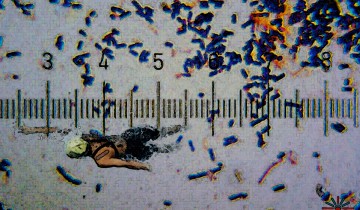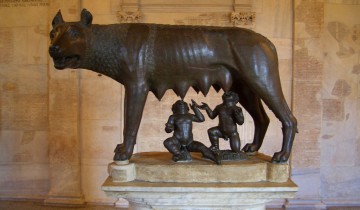By Roberta Attanasio, Forever Leaders Editor
What are the general principles of leadership? Not so long ago, a group of scientists—biologists, anthropologists, mathematicians, and psychologists—gathered at the National Institute for Mathematical and Biological Synthesis to answer this question from an evolutionary perspective. The scientists analyzed leadership patterns across a sample of mammalian species, and published their results in the journal Trends in Ecology and Evolution (January 2016). The article (Leadership in Mammalian Societies: Emergence, Distribution, Power, and Payoff) reveals that, while humans and other mammalians species exhibit different leadership patterns, they also share some leadership features.

Image credit: nist6dh, CC BY-SA 2.0
Jennifer Smith, lead author of the study, said in a press release: “While previous work has typically started with the premise that leadership is somehow intrinsically different or more complex in humans than in other mammals, we started without a perceived notion about whether this should be the case. By approaching this problem with an open mind and by developing comparable measures to compare vastly different societies, we revealed more similarities than previously appreciated between leadership in humans and non-humans.”
The scientists compared 16 different small-scale societies, including 8 human populations lacking complex political institutions—from Africa and North and South America, and 8 nonhuman groups: African elephants, bottlenose dolphins, chimpanzees, lions, meerkats, plains zebras, spotted hyenas, and white-faced capuchins. Evidence for leadership was evaluated in four domains—movement, food acquisition, within-group conflict mediation, and between-group interactions. Variation in leadership was measured in multiple dimensions, including emergence (how does one become a leader?), distribution (how widely shared is leadership?), power (how much power do leaders wield over followers?), relative benefit (do leaders gain more or less than followers?), and generality (how likely are leaders in one domain, such as movement or conflict resolution, to lead in other domains?)
As mentioned above, the study results show that, when comparing humans to other mammalian species, there are both similarities and differences in leadership patterns. Despite common assumptions often made around the notion of human uniqueness, the scientists found no clear divide between human and nonhuman social mammals with respect to the emergence of leadership. Indeed, in both humans and nonhuman species, leadership is generally based on individual achievement, gained through experience, as compared to inherited status. However, there are exceptions to this rule: leadership is inherited rather than gained through experience among spotted hyenas and the Nootka, a Native Canadian tribe on the northwest coast of North America.
In addition, the scientists found that human leaders generally wield less power than do nonhuman mammalian leaders—humans tend to develop specialized roles, with a minimal impact of dominance on leadership. These characteristics indicate significant evolutionary divergences between humans and nonhuman mammalian species.
There is still much to be learned. Indeed, Smith said: “As ambitious as our task was, we have only just scraped the surface in characterizing leadership across mammalian societies and some of the most exciting aspects of the project are still yet to come as biologists and anthropologists implement our novel scheme for additional taxa and societies.”
Copyright © 2016-2018 Forever Leaders.




Although humans have their distinct patterns of functioning, we are still just another species of mammals on this planet. Of course there are common behavioral patterns that we see when we are compared with other species. We, also, have placed an emphasis on leadership through inheritance for centuries, through monarchies. Perhaps other mammal species also accept leaders in this way, allowing power to be passed down through a ‘title’ of some sort, or a name.
Leaders are important for every society in order to help a group work together effectively. In this manner, any type of society will need someone to organize others. Perhaps this information can be passed through example and information to the future generation.
Hopefully leadership qualities will continue to be studied so that we will be able to find more similarities and patterns of behavior for humans and other animals.
Though this article relates human leadership to that of other mammals showing the similarities between human/animal social relationships in addition to hierarchies, I also want to suggest that there are actually leadership differences between human societies. If we look at the difference in leadership between the western and eastern world, there are stark differences in leadership. Companies in the western hemisphere tend to value individuality more so workers are often given a sense of individuality and freedom. Companies are motivated more by profit than service and unfortunately due to the laissez faire attitude of western corporations, selfishness and disorder can become the norm. On the other hand we have eastern corporations that value group cooperation, and the need to be harmonious. Workers often join together to accomplish a common goal. Though profit is a key motivator, so is organization and stability. This method of leadership can also be detrimental. Oftentimes the leader can gain too much power in these settings while the workers feel like they have an obligation to comply with the leaders request. The rigid stances in structure and organization keep many from exercising their freedom and creativity leading to lack of ideas to move the company forward. Overall these are just two generalized forms of leadership. We should acknowledge that even within humans we have different and similar leadership methods.
Some scientific discoveries have found that both humans and non-human species share a single common ancestor. Overtime, each present species branched off and were able to the species and diversity we see today. As each species branched off, I believe they developed characteristics that are similar to other species, regardless of the big difference that may exist. As provided by the article, these similarities can be seen in leadership strategies. The article explained that when comparing humans to other mammalian species, other mammalian species seem to wield more power. This might be attributed to the fact that humans have laws to guide them in almost every thing they do. Those in leadership positions are often scrutinized if they make the wrong decisions and the laws that are put into place serves as a boundary. These boundaries are necessary to make sure that a leader does not misuse his/her powers or that the leader does not exercise too much power. Compared to humans, a large percent of other mammalian species have no laws. Leaders wield more power and there is less control on the leaders. Overtime, it is possible to gain more knowledge about the difference between humans and other mammalian species.
Based on the fact that some scientific discoveries have led to the theory that the human species shares a common ancestor with some nonhuman mammals and that overtime the human species branched off from other mammalian species due the human species’ relatively unique brain, I would like to suggest that the differences in leadership between humans and nonhuman mammals stems from this difference in evolution. As humans evolved from hunters and gathers to farmers, developed tools, and formed societies, the type of leadership that humans needed in order to thrive evolved too. Humans do not have any natural predators, whereas all of the nonhuman mammals that were evaluated in the study included in the article do have natural predators or face some type of danger as a species to survive. This difference in dangers alone can account for the differences in leadership between humans and nonhuman mammals, because the leadership needed for each group to survive is very different. For example, a human leader does not need to be able to adapt how a community acquires food based on the presence of predators, but a meerkat leader does need to know this. Furthermore, a spotted hyena does not need to be able to predict the seasons to prevent its group from starving, but a human leader of a agriculturally based community does. The different dangers that humans and nonhuman mammals face causes the two groups to have different necessities in to survive, and as a result, different necessities in a leader. The varying leadership necessities also account for the varying amounts of power, leadership distribution, and generality. Due to the requirement of nonhuman mammalian leaders to have to often make life or death decisions for their communities, it is not surprising that they often are the sole leaders in all aspects and wield a large amount of power over the group. Whereas, humans are largely able to self sustain, human leaders are more likely to be required to make decisions regarding the progress of the community, so it is understandable that there are often multiple leaders for multiple aspects, those leaders share power, and they do dominate over those that they lead. The more knowledge we gain about what type of leadership humans and nonhuman mammals require to survive, the more the similarities and differences between human and nonhuman mammalian leaders will become clear.